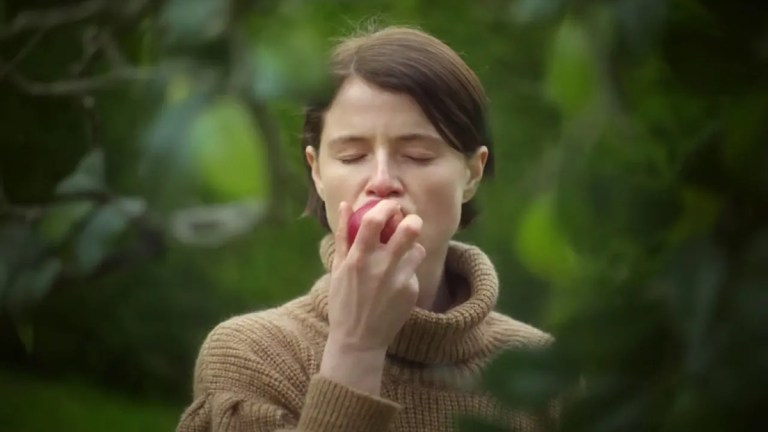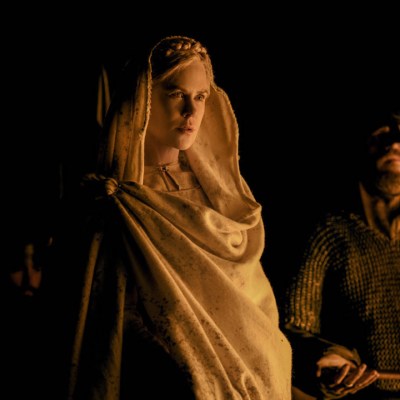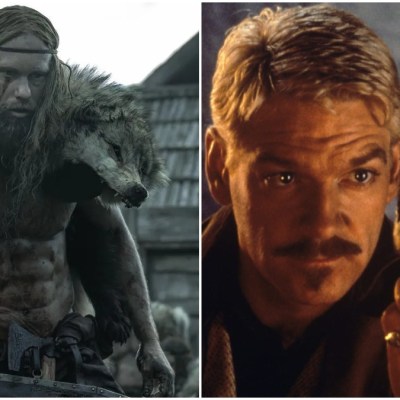Men Ending Explained
We dive into the multiple meanings and interpretations of the new Alex Garland horror movie, Men.

This article contains major spoilers for A24’s Men.
When it comes to interrogating the meanings and possible subtexts of Men, the new and formidable surrealist horror film from Alex Garland, the filmmaker is unusually circumspect. As a storyteller who appears always as erudite as the films he’s written—which include 28 Days Later, Never Let Me Go, and his previous directorial efforts of Ex Machina and Annihilation—Garland is again thoughtful while discussing Men ahead of release. But perhaps more so than any of his previous projects, he also feels a need to be ambiguous about a movie that shockingly ends with the sight of Rory Kinnear birthing himself. Repeatedly.
“It all gets a bit psychoanalytical if I talk about it too much,” Garland said during a press conference following a screening Den of Geek attended. “I think it might get in the way.” He eventually went on to add, “In this particular film, I especially wanted to step back, because there’s an element where the nature of the way it’s interpreted by different people is what the film is.”
Fair enough. More so than even most films, Men is an art piece that defies any singular interpretation or explanation as to why things happen the way they do, including how Jessie Buckley’s Harper is bedeviled by a hundred variations on the same face (an often grinning Rory Kinnear); or, later, why that face sprouts leaves and eventually reveals it houses a womb in which it will continually reproduce itself until the man Harper once married (Paapa Essiedu) returns from the dead to pitifully haunt her one more time.
It all demands to be interrogated, even as it defies ever giving a clear cut answer. Even so, we think there are enough context clues within the film, right down to the Green Man sculptures that Garland frequently cuts to, to explain why the self-procreating Kinnear articulates a basic, elemental horror that exists in the relationships between men and women, and how it’s always been there. So let us explain our interpretation.
Why All Men Look the Same
The initial hook into Men, even from the trailers, is the uneasy anxiety that builds when you realize all the men in Harper’s life, other than her dead husband, look the same: they’re all Rory Kinnear. He plays the first man Harper meets during her holiday into the country when he shows up with bad teeth and a faint air of friendly superiority as Geoffrey, the groundskeeper. He’s all smiles and pleasant blather in those scenes, yet even then he pointedly begins his relationship with Harper by admonishing her for eating an apple from the garden—like Eve of yore.
He turns out to be one in a sea of indistinguishable faces as Kinnear also plays the lusty vicar who more pointedly criticizes Harper for not letting her late husband James “apologize” for hitting her; he’s also both the local copper and the criminal, with the latter attempting to break into Harper’s house while entirely in the nude, and the former not being much better when he releases the nameless tramp with a slap on the wrist.
Kinnear’s face is even digitally superimposed on a little boy who calls Harper “a bitch” inside of a minute.
The obvious reading that the film invites is that all men are the same: one ogling grotesquerie out to torment and possess any woman within reach. With that said, Garland did offer us this breadcrumb during a roundtable interview we participated in.
“One question might be if Harper sees all men as the same?” Garland says. “Because neither Harper nor the film ever remarks on it, ever. Only the viewer is left to remark on it. So is it that Harper sees all men as the same whilst they are in fact different, or is it all men are the same and she does not see that? They’re two questions that sound very similar but have completely different inferences.”
It’s a pointed distinction, however we suspect it’s close to misdirection. what matters is not that they all look the same; it’s that they all affect Harper in the same way by providing a primal sense of menace and oppression.
Personally, I do view them as different characters insofar as their level of menace fluctuates until they form a single patriarchal monstrosity in the film’s climax. Initially, the naked stalker is far more unsettling than the little boy in a Halloween mask. But cumulatively they build the same suffocating cage Harper’s been pushed into all her life. Perhaps for that reason, outside of the aforementioned stalker, the most threatening is initially the vicar, who comes to allegedly console Harper after he hears her cries of anguish in his church.
Sitting by her side, he’s able to present a modern mask of authorial kindness as the ancient customs and associations society has for the collar remain benevolent. It is strongly implied Harper is not a religious person, nor ever had a glorified confession in front of a Man of God. And yet, she spills her deepest secrets: that she threw her husband out on the afternoon he struck her for the first time, and that she made eye contact with him again as he plummeted to his death, unsure whether his fate was one of suicide or stupidity in trying to get back into their apartment.
And it’s that ancient right of “confession” (in the general sense, if not the Catholic one) that allows the vicar to abuse his paternal authority and judge her for her supposed guilt in James’ death. And he more than judges; he gets to be the one to later explicitly state the lascivious thoughts that so many men have had about her.
“I’ve seen you with your mouth open,” the vicar says at the climax. “With your legs open, and in every [conceivable position]… That is the power you have over me.”
It doesn’t matter if all men are the same or not, they all are supported—some to far greater degrees than others—by a system that allows them the same horrific imbalanced power over Harper. And they all have the capacity to hold her as “responsible” for their own sins.
The primal terror of that is something women have dealt with since time immemorial, which is what the rest of Men’s ending is really getting at.
Why Rory Kinnear Becomes the Green Man
This gets back to the most basic and primordial image that haunts Harper’s subconscious state as much as the ghost of her husband: the Green Man. His impenetrable yet staring visage percolates the film just as much as the less famous Sheela na gig, a similar feminine carving from medieval architecture in which a woman is graphically depicted as spreading her womb.
Both images appear in Men as edifices that adorn a cathedral. They then linger in Harper’s mind until Kinnear’s malevolent presence transmutes into the Green Man: a deity-like creature who seems to infect Harper with spores from his mouth.
According to Garland, the idea of Men grew out of his fascination with Green Man carvings that can be found throughout Europe and beyond, with the earliest known versions dating back to at least the second century C.E. Their primitive power lies in their inexplicability, and why throughout the Middle Ages they were subsequently adopted by Christian churches.
“There’s not really very much information about them,” Garland says. “Sometimes people, academics or Wikipedia or whatever, presents some kind of explanation for them, but there really isn’t a clear, real good explanation because they predate written language in [those cultures].”
Indeed, a popular but academically unfounded theory came from Julia Somerset, also known as Lady Raglan, who coined the term ‘Green Man’ in a 1939 article she wrote about the figure and British folklore. In that same piece, she posited that “the fact is unofficial paganism subsisted side by side with the official religion, and this explains the presence of our Green Man in a church window with the Virgin beside him and below him in the sun.”
While Men does not dwell that heavily on the relationship between the pagan imagery of the Green Man and Christian imagery, it’s the persistent unwavering misogyny they both represent which haunts Garland’s screenplay and Harper’s nightmares.
Like Lady Raglan, Men views the Green Man as a relic from a world before Christianity helped shape our modern one. Yet the same values the Green Man seems to suggest (at least in Garland’s interpretation), which involve a lustful desire of women, have persisted in continuity with the past. It even offers a grim interpretation of the vaginal Sheela na gig carvings, which come entirely from a medieval and Christian world, yet are married to the Green Man in Garland’s film as the object of his desire. It’s “the power you have over me.”
In this way, Garland is suggesting this is not a current issue about a so-called “battle between the sexes,” or even one defined by a cynical view of Christian patriarchy. Rather this is monstrosity that has existed within men’s treatment of women since before a written history.
“I knew that I wanted some old representation in this, as well as some sort of current representations,” Garland says when we ask about the juxtaposition of the pagan and Christian imagery. “So this doesn’t feel like it’s talking about a particular moment in time; it stretches back much further than that.”
So whether it is Geoffrey joking about Harper for eating from the forbidden fruit of an apple on a tree—where Garland deliberately mimics a Judeo-Christian image still used to this day to justify forms of misogynistic control over women—or Geoffrey’s actual face turning into a Green Man, this is something ancient and eternal. And no matter how modern or aware Harper is of it, she cannot escape its infection when it breathes its influence (or spores) down her throat.
Why Does Rory Kinnear Birth Himself Six Times?
All of which gets back to the most bizarre moment in the movie: Kinnear’s Green Man reveals his own vaginal womb in which (by my count) five different generations of other Kinnears are born, each more feeble and pathetic than the last, and each carrying the scars and slights they blame women for, as made literal by the hand Harper cleaved down the middle with a knife.
It’s a wild image that likely alienated more than a few audience members. However, we found it made the movie, as Men finally gave a grander visceral shape to the horror it had been tiptoeing around up until this fever dream moment.
Before this finale, we’ve been watching Harper deal with her own personal anguish over the loss of James (more on that in a minute), and how he and the culture at-large held her responsible for both his hitting her and his subsequent demise. This is her personal time “to heal,” as her friend says.
However, Men takes its horror fable to a macro level at the end since not only does Kinnear embody all the men in this single upside-down village; he embodies men throughout the history of the species. The cycle of toxic masculinity is passed down from generation to generation, with past ages grievances about women still carried forward into the future.
We see that in a deceptively more benign way when Geoffrey begins the third act appearing to try and help Harper. He calls her a “damsel in distress” when he finds her terrified by a man trying to break into her house at night, and then reluctantly agrees to go search the grounds in the dark to protect her. He announces that decision by saying, “You have all the qualities of a failed military man.” That is what Geoffrey’s father apparently told him when he was seven years old.
The way scared boys become broken men, and how the ugliness of previous generations is internalized by their children in the next, is right there in Geoffrey’s initially self-deprecating smile—before he later turns it into a sneer and drags Harper by the hair, mocking her for daring to travel without a husband or man to protect her.
Now in the movie’s final moments, we see in visceral detail how endless iterations of toxic masculinity has created something feeble and pathetic. Garland notes this is the inversion of most horror movies where instead of the monster growing stronger and more threatening, it becomes more helpless with each passing birth between Kinnear’s legs. Each ‘child’ also carries the same wound they blame women for on their broken hand.
This has gone on for millennia—from the pagans of the Celtic British Isles to the modern vicar of today—and on it goes until we reach Harper’s modern, secular man, James.
What It Means That Harper’s Husband Comes Back
In the final form of a creature that begins with the Green Man and ends in the 21st century, we get James, a bloke whose own neolithic insecurities appeared to surprise even Harper and himself. The first image we see in the film is the moment of his death, when he makes eye contact with Harper as plunges from the floor above.
In later flashbacks, we learn Harper began that afternoon by telling James their marriage was over; she’s leaving him. The way that Buckley and Essiedu play the moment is fascinating because they’re clearly meant to be a contemporary, posh London couple who’ve never had a moment of physical violence before this day in their relationship. The performances even suggest they’re surprised at how base they can both become as James turns things dark by promising to kill himself if she really leaves him, and her screaming for her need to extricate him from her life.
It is at this point he punches her, shocking as much himself as his soon-to-be ex-wife. Her justified rage is thus both at his betrayal and hitherto unseen capacity for violence and sense of possessiveness.
Yet she cannot shake a sense of guilt over his death. Perhaps this is because of the inability to know if it was suicide? Either way, it’s to the vicar she makes a strange, extraneous observation: Could he see her as he plummeted to his death? “That’s not possible?” she asks as much to herself as him.
Of course James could. We saw them make eye contact in the first scene. It’s their moment of recognition that makes the death so surreal.
But Men is speaking to a larger recognition. She tells the vicar she must’ve imagined seeing him, because for the first time she saw how pathetic and unable James was to fight against the larger forces that, like gravity, would drag him down to a bitter end. But perhaps he, too, could see her for the first time in his life as a woman trapped inside of a cage he wants to hold her in—a possession unable to get outside.
At the end of the film, she is still trapped, unable to leave the house when she decides to escape the country. The Men take her car and attempt to take her agency, entombing her in a house as ultimately claustrophobic as the apartment where she saw James die.
And it’s there, at the end of things, she sees the Green Man through many generations become James, a pitiful, weak man-child who since before he was born has been ruined by ancient forces, both biological and sociological, into doing horrible things. Finally, Harper is forced to ask why things are this way?
“James, what is it you want from me?” Harper demands with a justified sense of exasperation.
“Your love,” he pleads in the movie’s final line.
Men have created a massive, inescapable worldwide cage to trap “a love” that they cannot fully comprehend. Harper finally sees and understands James. And she is thus free of his ghost. Hence why when her friend finds her in the post-credits sequence, she is smiling and at last liberated from that guilt of that relationship and its memory.


